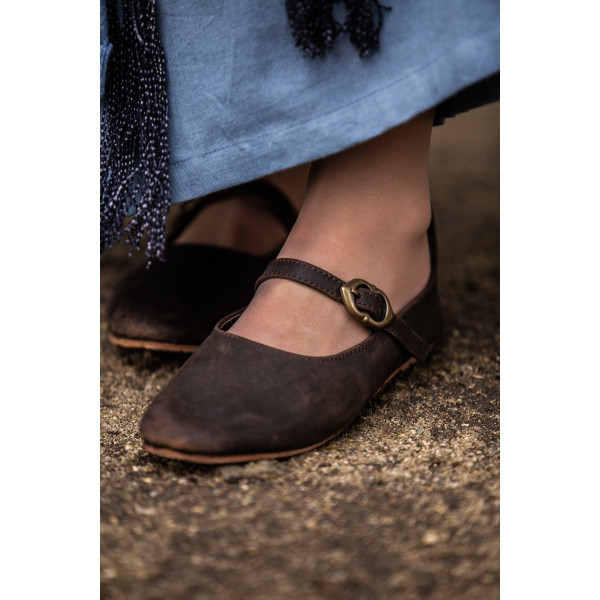The medieval era, a period spanning roughly from the 5th to the late 15th century, was an epoch of both profound historical changes and remarkable sartorial expression. Part of this expression was found in the footwear of medieval women, which is often overlooked but holds an undeniable place in the tapestry of fashion history. This exploration of medieval women’s shoes will uncover their styles, the social significance they carried, the materials and craftsmanship involved, the influence of geographical variations, examples of notable surviving pieces, and the revival of these designs in modern fashion in 2024.
Styles Across Social Hierarchies
From Patter to Poulaine: Footwear for All Classes
Medieval women’s shoes varied widely in style, reflecting both the wearer’s social status and the prevailing trends of the time. For the peasantry, simple, practical, and durable shoes, such as slip-on shoes called ‘pattens’, were common, designed for labor and longevity. In contrast, noblewomen donned more extravagant styles like the pointed ‘poulaine’, which could indicate wealth and social ranking.
The Decorum of Decorations and Colors
Wealthier medieval women enjoyed shoes made from finer materials and adorned with decorations such as embroidery, jewels, and elaborate stitching. Bright colors were also a mark of nobility, as dyes were expensive and considered luxurious. These aesthetic choices made the statement of affluence and fashion-consciousness in an age where appearances were closely tied to one’s social position.
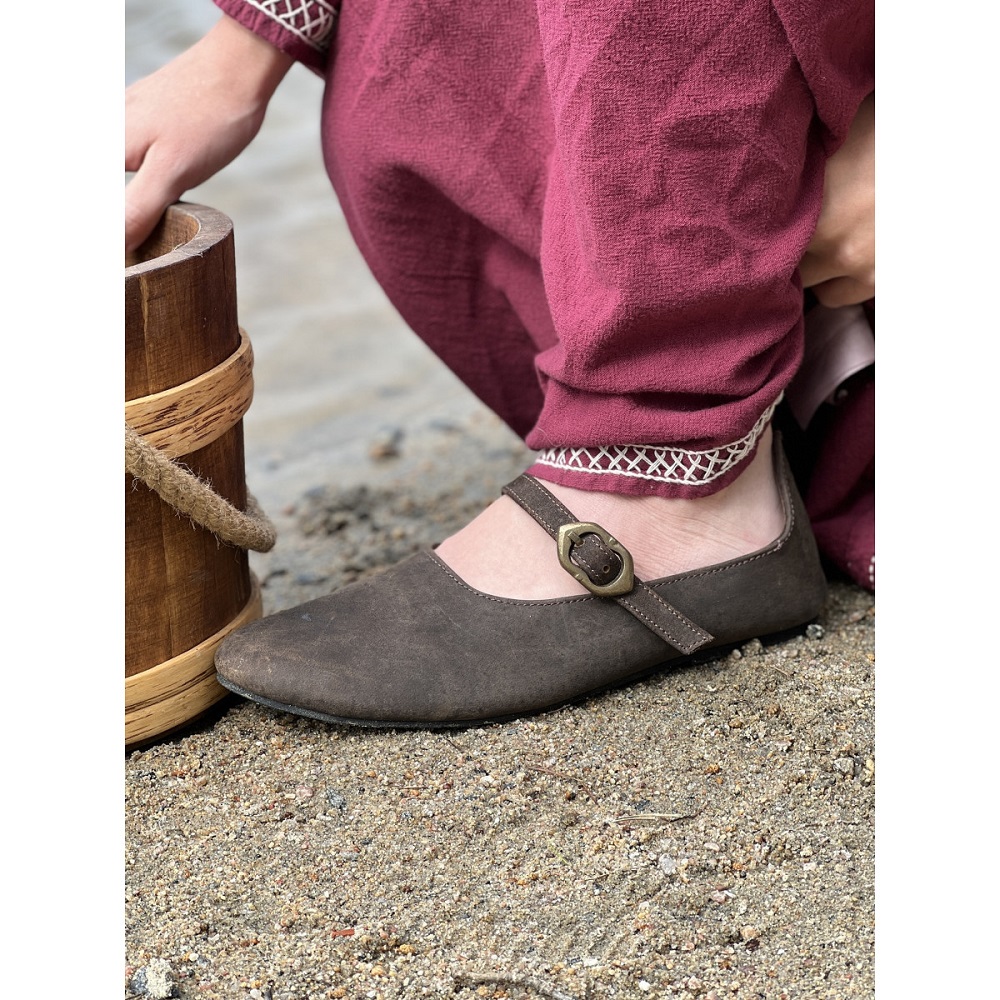
Materials and Craftsmanship
Leather and Luxury: Crafting Medieval Footwear
The most common material for making medieval shoes was leather, valued for its durability and pliability. Timeless women’s shoes often used softer leathers, sometimes sourced from goats or sheep, which allowed for more comfortable and refined fits. Skilled cobblers employed techniques that have been passed down through generations, forming the foundation of modern shoemaking.
Innovations in Shoemaking Techniques
The medieval period saw advances in shoemaking that are still influential today. Cobblers began using wooden forms, called ‘lasts’, to give shoes their shape. They also developed methods for making waterproof soles and heels, which improved the practical aspects of the shoes significantly. This progress laid the groundwork for the intricate and high-quality footwear we recognize now.
Social Significance and Symbolism
Footwear Symbolizing Status and Virtue
In medieval society, shoes were more than just protective garments for the feet; they were laden with symbolism and conveyed messages about the wearer’s identity. Longer, pointed shoes, for example, were associated with higher social standing and sophistication but sometimes drew criticism from the church for being too extravagant or vain. Consequently, shoes were not only fashion items but also social indicators and conversation pieces.
Modesty vs. Ostentation: Balancing Appearances
While opulent shoe styles were in vogue, there was a fine line between fashionably ostentatious and being perceived as ostentatiously immodest. Medieval women had to navigate these waters carefully, choosing shoes that reflected their status without crossing into the realm of excess, as societal norms dictated a modest appearance, particularly for women.

Geographical Influence on Shoe Design
Adaptations to Climate and Culture
The design of medieval women’s shoes was not only influenced by social status but also by the geographical conditions and cultural norms of different regions. In colder climates, shoes had to provide more coverage and warmth, leading to the use of fur linings or higher boots. Meanwhile, in the Mediterranean areas, open-toed and lighter shoes were more common, suitable for the warmer weather.
The Cross-Cultural Exchange of Styles
Trade and cultural exchanges between regions brought about a fusion of shoe styles throughout medieval Europe. Crusades and travels to the Orient introduced European women to new designs and materials, which they adopted and adapted, creating a blend of Eastern and Western fashion elements in their footwear.
Surviving Examples and Artifacts
The Lendbreen Tunic and Other Findings
Remarkable examples of medieval women’s shoes have been unearthed at archaeological sites, offering insights into the design and construction of these artifacts. One notable discovery is the Lendbreen Tunic, which included well-preserved shoes, allowing historians to study the materials and methods used in the medieval period.
Shoes Preserved in Art and Literature
Besides physical artifacts, medieval women shoes also live on in paintings, sculptures, and writings. These depictions give us a glimpse into the fashions of different periods and help us understand the symbolic meanings attributed to these shoes. Artistic portrayals often show intricate details and offer contextual cues about the shoes’ significance in medieval life.
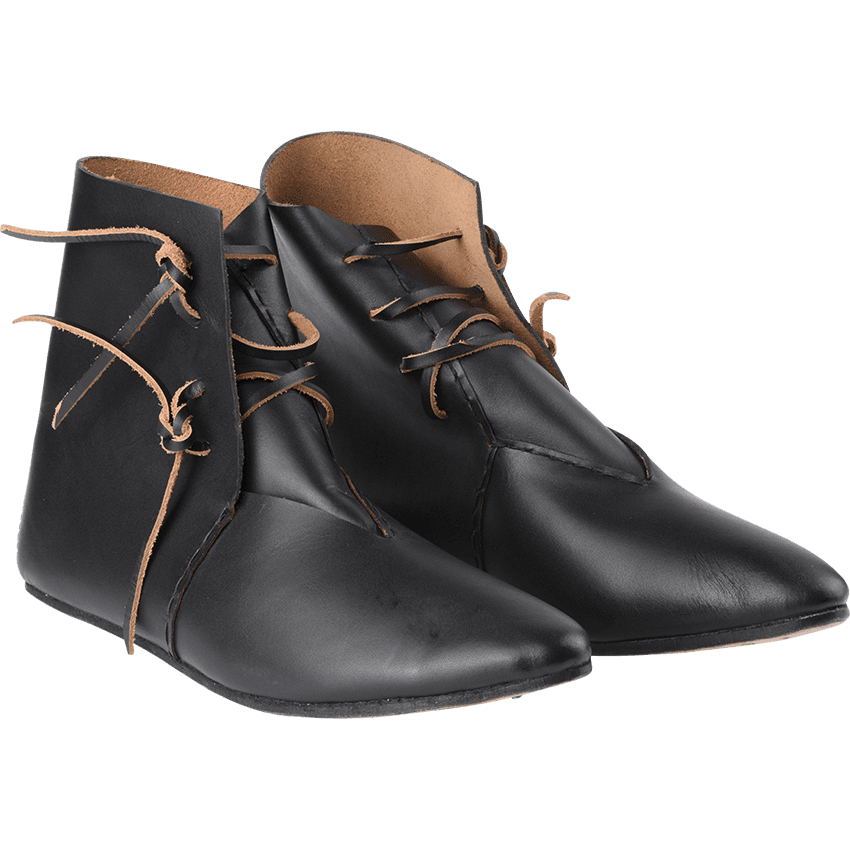
Modern Revivals and Fashion Inspirations
Medieval Influence in Contemporary Design
The elegance and history of women’s shoes in medieval times have inspired modern shoe designers, leading to a revival of medieval styles in contemporary fashion. Pointed toes, ornate decorations, and the use of luxurious materials are echoes of medieval craftsmanship and aesthetics found in today’s high-end footwear collections.
Crafting a Neo-Medieval Look
Today’s fascination with historical fashion has also spurred a neo-medieval trend. Designers craft shoes that pay homage to the past while catering to modern comfort and style preferences. These creations merge age-old elegance with present-day sensibilities, proving the timeless appeal of medieval-inspired footwear.
The Artisanal Touch
Mastery Behind Every Stitch
The creation of medieval women’s shoes was a labor of love and skill. Artisans trained for years to perfect their trade, often becoming apprentices at a young age. The shoes they crafted by hand were bespoke, ensuring a unique fit for the wearer. These artisans paid attention to the smallest details, from the stamping of patterns into leather to the careful placement of each stitch. The scarcity of automated technology meant that each shoe was a direct product of human skill and artistry.
Preservation of Shoemaking Traditions
Modern technology has transformed the shoemaking industry. Yet, aspects of the medieval artisanal approach still survive. This survival is seen in bespoke shoemaking. It is also present in regions where craftsmanship is prized over mass production. The crafting of shoes in the medieval era formed a foundation. This foundation is for an enduring art form. The legacy of this art form continues. It captivates those who value the handcrafted. These individuals prefer handcrafted items over the machine-made.
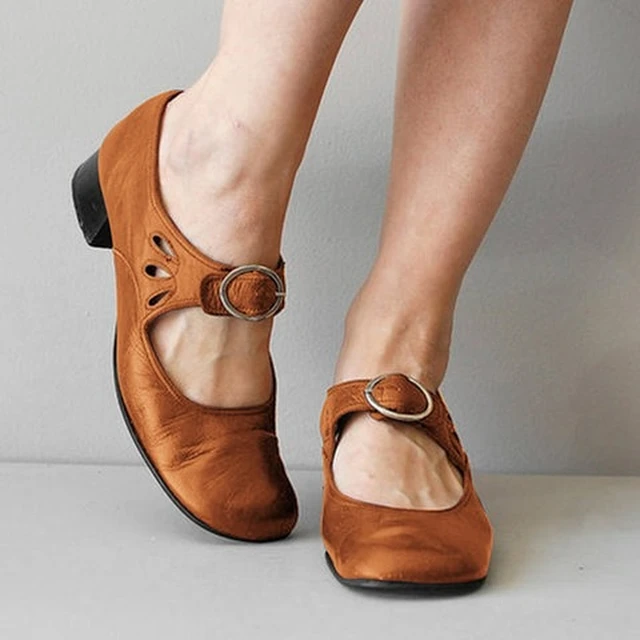
Rituals and Symbolism
Shoes in Ceremonies and Traditions
In medieval times, shoes weren’t just practical items; they held a significant place in the rituals and customs of society. For instance, a common wedding tradition involved the groom gifting his bride with a pair of shoes. This symbolized the transfer of caretaking duties. Shoes were also used in ceremonies of knighthood and aristocracy. They played a performative role in these ceremonies. This role included the designation of power and responsibility.
Socio-Religious Implications of Footwear
The church played an influential role in dictating the appropriateness of certain fashions, including footwear. Shoes that were too pointed or ornate could attract disapproval from religious leaders who believed in modesty and humility. As such, the design and wear of shoes could reflect larger societal issues, including tensions between secular desires and ecclesiastical demands.
Medieval Shoes and Gender
Feminine Footwear as an Expression of Identity
Shoes in the medieval era were often gender-specific, with women’s styles exhibiting certain shapes and decorations that conformed to contemporary notions of femininity. Footwear thus became an extension and expression of one’s gender identity. The materials, construction, and even the sound made by walking were carefully considered to maintain and project a woman’s social presence and femininity.
Markers of Morality and Conduct
The types of shoes a woman wore could speak volumes about her character and expected behavior. A strict moral code often governed women’s fashion, and adherence to this code was visible in the choice of shoes. By complying with these norms, women’s footwear became a visual marker of morality and propriety within medieval society.
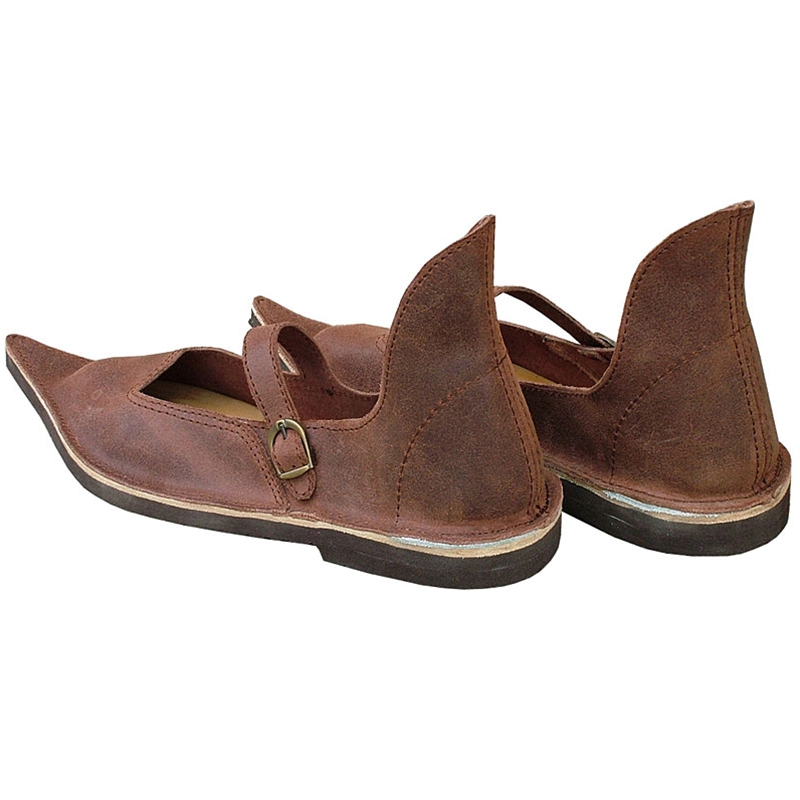
Revival in the Digital and Entertainment Age
Medieval Footwear in Media and Pop Culture
With the rise of digital media, medieval women’s shoes often make appearances on-screen. They capture the imagination of modern audiences. These reproductions help to spark conversations about historical accuracy. They also highlight the significance of fashion in storytelling. Additionally, the fantasy genre, inspired by medieval aesthetics, has embraced these styles. This introduces them to new generations. Often, this leads to a renewed interest in the period’s fashion.
Nostalgic Yearnings and Reenactment Communities
There exists a community of history enthusiasts and reenactors. They strive to bring the past to life. This includes the accurate recreation of medieval attire. Shoemakers within these communities use traditional methods. They craft shoes that are as faithful to the originals as possible. This attention to historical detail serves educational purposes. It also feeds a nostalgic yearning. This yearning is for the craftsmanship and beauty of the past.
In sum, medieval women’s shoes are a potent symbol. They symbolize the era’s cultural fabric. This fabric is woven with strands of utility and artistry. It also includes societal norms and identity. These shoes continue to hold importance as historical artifacts. They serve as educational tools. And they are sources of inspiration for the fashion-forward. They started as the creations of skilled craftsmen. Now, they play roles in contemporary culture and media. Medieval women’s shoes have traversed a remarkable journey. This journey confirms their lasting imprint on history and style.
